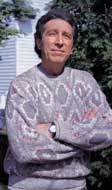 A fighting chance Dan Blasucci was running out of options when he came to UC Davis Medical Center in 1999. Twenty years earlier, he had fought Hodgkin's disease, a cancer of the lymphatic tissue, to a standstill. With aggressive treatment and scrupulous attention to good health, the disease stayed in remission, out of sight, almost out of mind, while Blasucci started a family and a business. Then some of his old symptoms came back. He lost weight and felt tired. One day when he was on a plane, he sneezed and broke a rib - not a typical event for the hardy New Yorker. Tests revealed his worst fears. He had advanced (stage IV) non-Hodgkin's lymphoma, a cancer very similar to the Hodgkin's disease he had battled earlier. His prognosis was grim. Non-Hodgkin's lymphoma is a common cancer that occurs when malignant white blood cells change and multiply. They crowd out healthy cells and create tumors that cause the lymph nodes to swell - one of the disease's first noticeable signs. Better therapies have improved survival rates, but for unknown reasons, incidence of the disease has doubled in the last 20 years. An estimated 65,000 Americans will be diagnosed with non-Hodgkin's lymphoma or its more rare counterpart, Hodgkin's disease, this year. Another 27,000 will die from it. Doctors told Blasucci the lymphoma had spread to his chest and was, as he describes, "eating away at my ribcage." He went through 11 cycles of conventional chemotherapy, with so-so results. He took a new drug that stimulates the immune system to attack lymphoma cells. It shrank his tumor but tests showed the disease was still alive and active in his body.
Home |
Table of Contents |
To our Readers |
Building on Basics UC Davis Health System | © 2000, 2001, 2002 UC Regents. All rights reserved. |
When
conventional therapy fails, cancer patients come to the radioimmuno- |

